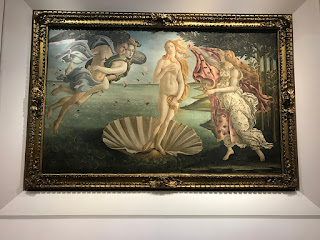What a thrill to arrive in Florence for a 17-day visit. So much to see, so much to do! So I start with the Uffizi Gallery. Here is a view of the Ponte Vecchio spanning the Arno River as seen from the Uffizi. Click on any photo to enlarge.
The Uffizi is home to great sculpture and paintings of the ancient Greeks and Renaissance Italians. The Medici family collected and commissioned the items in the gallery.
Bacchus with grapes, Greek marble, 1st-2nd century CE, with 16th century restorations:
Giovanni Caccini (1556-1613), Hercules and Nessus.
This piece has been in the same location since 1595:
Cupid and Psyche, unearthed in a garden on the slopes of the Celian Hill in Rome in 1666. The work, which can be dated to the second half of the 2nd century CE, is a Roman interpretation of a Hellenistic original developed in the late 2nd century BCE:
Paolo Uccello, The Battle of San Romano, ca. 1435-40:
One wing of the Gallery, lined with sculptures, and ceilings covered with elaborate paintings.
Sandro Botticelli, Spring (late 1470s or early 1480s):
Botticelli, Birth of Venus (ca. 1485):
The Accademia Gallery is a smaller museum than the Uffizi and houses several sculptures by Michelangelo (1475-1564), including his David and many unfinished pieces.
Michelangelo Pietà
Michelangelo, Prisoner, unfinished work for the tomb of Pope Julius II
The Accademia contains a collection of historical musical instruments.
Here is a cello by Nicolò Amati from about 1650
Tenor viola 1690 by Antonio Stradivari:
By now, I am suffering from Stendhal Syndrome.
Marie-Henri Beyle (1783–1842), better known by his pen-name Stendhal, was a 19th-century French writer. Best known for the novels Le Rouge et le Noir (The Red and the Black) and others.
In 1817 Stendhal was reportedly overcome by the cultural richness of Florence he encountered when he first visited the Tuscan city. As he described in his book Naples and Florence: A Journey from Milan to Reggio:
As I emerged from the porch of Santa Croce, I was seized with a fierce palpitation of the heart (that same symptom which, in Berlin, is referred to as an attack of the nerves); the well-spring of life was dried up within me, and I walked in constant fear of falling to the ground.
The condition was diagnosed and named in 1979 by Italian psychiatrist Dr. Graziella Magherini, who had noticed similar psychosomatic conditions (racing heart beat, nausea and dizziness) amongst first-time visitors to the city.
In homage to Stendhal, Trenitalia named their overnight train service from Paris to Venice the Stendhal Express.
Click HERE for the next page on the Italian tour
Click HERE for the next page on the Italian tour













No comments:
Post a Comment